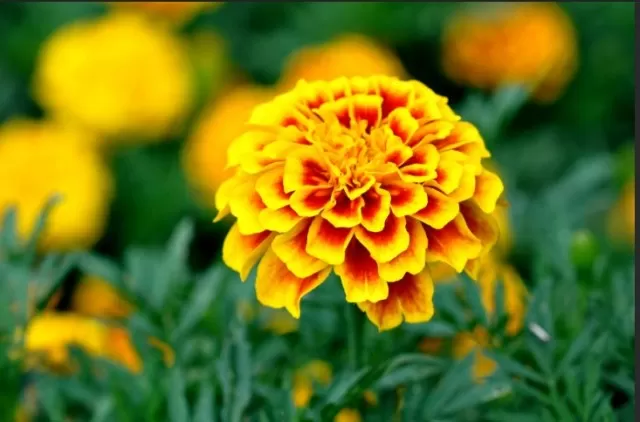Plants to Cultivate for Mosquito-Free Outdoor Areas, Cultivating these guardian plants doesn’t just end with planting.Regular maintenance and care, from pruning to deadheading, ensure their vitality and resilience. As these plants flourish, they gift you with both their repellant properties and their inherent beauty, transforming your garden into an outdoor sanctuary that resonates with life’s intricate rhythms.
Nature’s wisdom holds the key to pest control and garden enrichment. By cultivating these herbs, flowers, and vegetables that mosquitoes shun, you become a steward of your outdoor space, fostering an environment that encourages flourishing life while discouraging unwanted intruders. The result? A garden that not only thrives but also brings a renewed sense of tranquility, beauty, and the satisfaction of a harmonious coexistence with the natural world.
The Dual Nature of Catnip: A Natural Mosquito Repellent and Ornamental Perennial

Catnip, scientifically known as Nepeta, harbors a fascinating duality within its leaves.
Nepetalactone, the chemical compound responsible for its allure to felines, takes on an entirely different role when it comes to mosquitoes. Contrary to its appealing effect on cats, nepetalactone proves to be a potent mosquito repellent, surpassing the effectiveness of the widely used commercial chemical DEET, as indicated by various research studies.
Beyond its insect-repelling properties, both varieties of nepeta—catnip and catmint—unveil their aesthetic prowess through charming spikes of flowers that grace the landscape from the early days of spring to the waning moments of fall.
While catnip boasts pristine white blossoms, catmint presents an elegant lavender hue. The allure of these blooms adds a touch of natural beauty to any garden or outdoor space.
A noteworthy aspect of nepeta plants is their remarkable resilience.
As perennials, they faithfully return year after year, gracing gardens with their presence and enhancing the overall landscape. To ensure their flourishing growth, providing ample sunlight is essential.
Moreover, allowing the soil to experience a gentle drying period between watering sessions contributes to their optimal development.
In conclusion, catnip, scientifically referred to as Nepeta, stands as a prime example of nature’s multifaceted wonders.
Its remarkable ability to attract cats while simultaneously repelling mosquitoes showcases the intricate balance within the plant’s chemistry. Furthermore, the ornamental value it brings, with its delicate flowers and reliable perennial nature, makes it a cherished addition to Outdoor Spaces that cater to both visual appeal and functional elegance.
Harnessing Nature\’s Power: The Citronella Plant – More Than Just Candles
While the mention of citronella might conjure up images of flickering candles warding off mosquitoes during twilight gatherings, there’s a deeper story behind this potent aroma.
The unmistakable and robust scent that mosquitoes find so repugnant is actually extracted from the leaves of the citronella plant, often referred to as the mosquito plant. Beyond its role in creating insect-repelling candles, the citronella plant itself stands as a remarkable guardian against these pesky intruders.
Sporting a graceful grassy appearance, the citronella plant boasts both practicality and beauty.
Its inherent mosquito-repellent properties make it a sought-after addition to gardens and outdoor spaces. Not only does it serve as a natural deterrent for mosquitoes, but it also brings a touch of elegance to any landscape with its delicate yet vibrant foliage.
A hardy survivor, the citronella plant exhibits a commendable resilience to drought conditions, making it an ideal choice for those seeking low-maintenance green companions.
It thrives under the nurturing embrace of afternoon shade, which provides a respite from the sun’s intense rays. When it comes to soil, the citronella plant favors rich, fast-draining earth—a formula for its prosperous growth and development.
It’s important to note that while the citronella plant offers invaluable mosquito protection and aesthetic appeal, it typically assumes the role of an annual.
As colder temperatures settle in with the arrival of frosty weather, the plant’s journey concludes, and it doesn’t return with the changing seasons. Despite its ephemeral presence, the citronella plant’s contributions to pest control and outdoor aesthetics are undeniably impactful.
In summation, the citronella plant transcends its reputation as a mere source for scented candles.
Its leaves yield a fragrance that repels mosquitoes, embodying the essence of natural defense against these bothersome insects. Beyond its functional benefits, its graceful appearance, ability to withstand adverse conditions, and preference for specific environmental conditions make it a prized asset for both seasoned gardeners and those new to the world of horticulture.
Lavender: A Tranquil Oasis with Mighty Mosquito-Fighting Abilities

The enchanting fragrance of lavender has long captivated hearts, inviting a sense of calm and tranquility.
Yet, beneath its calming allure lies an unexpected secret: lavender, with its exquisite purple blossoms, emerges as a powerful guardian against mosquitoes. This perennial gem not only offers relaxation but also wields impressive mosquito-controlling capabilities, making it a standout choice for both sensory delight and pest management.
Among the myriad varieties of lavender, each harboring its own unique charm, a shared preference for abundant sunlight and slightly arid soil unites them.
Basking in the sun’s warm embrace, lavender thrives and flourishes, adorning gardens with its iconic, soothing hues. Its resilient nature shines through as it endures periods of dry soil, showcasing its adaptability to varying environmental conditions.
To encourage a continuous flourish of blooms, a little TLC in the form of deadheading goes a long way.
By snipping away spent blossoms, lavender plants channel their energy into producing fresh bursts of vibrant purple, intensifying the visual spectacle they offer.
Beyond their aesthetic and olfactory gifts, lavender plants play an unexpected role in the realm of pest management.
By naturally repelling mosquitoes, they create an environment that’s both pleasing to the senses and inhospitable to these unwelcome insects. This harmonious blend of beauty and utility cements lavender’s status as a multi-faceted botanical wonder.
In summation, lavender transcends its reputation solely as a source of relaxation-inducing aroma.
Its regal purple blooms symbolize not only tranquility but also nature’s prowess in pest control. Through their shared affection for sunlight, ability to thrive in dry soil, and dedication to continual reblooming, lavender plants beckon both garden enthusiasts and pest-conscious individuals alike to embrace their botanical brilliance.
Lemon Balm: Nature\’s Dual Marvel – Mosquito Repellent and Soothing Elixir
In the kinship of mints, lemon balm emerges as a refreshing revelation, graced with a citrusy aroma that sends mosquitoes fleeing.
This aromatic herb not only possesses the power to repel these airborne nuisances but also offers a delightful twist—its leaves, when dried, transform into a soothing lemon-flavored tea, known to gently lull one into peaceful slumber. Lemon balm’s versatility extends from mosquito control to bedtime indulgence.
The zesty fragrance emitted by lemon balm leaves serves as a potent deterrent to mosquitoes, creating a shield against their incessant intrusion.
This natural defense mechanism is a gift to outdoor spaces, inviting relaxation without the disturbance of these pesky insects.
For those seeking solace and rest, lemon balm presents an equally captivating offering.
Once its leaves are carefully dried, they metamorphose into a herbal infusion, bursting with the refreshing essence of lemon. This infusion, when transformed into tea, becomes a gentle sleep-inducing elixir, comforting both the senses and the restless mind.
To nurture lemon balm’s dual capabilities, finding a partially shaded location is key.
This herbaceous wonder thrives in spots where sunlight is tempered by intermittent shade, enabling it to display its verdant charm while maintaining its resilience. Adequate moisture in the soil is essential for optimal growth, but striking the balance to prevent over-saturation ensures the health and vitality of these multifaceted plants.
In essence, lemon balm takes its place as an exceptional botanical gem.
Its aromatic allure repels mosquitoes, safeguarding outdoor serenity, while its leaves, when harnessed and dried, yield a sleep-inducing tonic that eases the cares of the day. This herb’s ability to simultaneously enhance relaxation and fend off pests underscores the ingenious elegance of nature’s design.
Marigolds: Nature’s Bright Guardians Against Mosquitoes

Amid the vibrant tapestry of marigold varieties, with their cheerful hues of yellow, gold, white, or orange, lies a remarkable secret weapon against mosquitoes.
These summer blooms, adored for their vivid beauty, carry a potent message that tells these pesky insects to “bug off. ” Beyond their mosquito-repellent prowess, marigolds offer effortless growth, thriving across landscapes with ease.
Particularly at home in containers basking in sunny expanses, these blooms hold a unique place in both gardening and pest control.
The radiant shades that marigolds boast are far from superficial.
They contain within them a natural command that repels mosquitoes, creating a safe haven for outdoor gatherings and moments of leisure. This innate quality sets marigolds apart as not only visual delights but also protectors of serenity.
Marigolds, ever the cooperative companions, extend their resilience to various growing conditions.
Their adaptability shines when cultivated in containers, gracing balconies, patios, and gardens alike. Bathed in sunlight, marigolds flourish, enveloping their surroundings with a burst of joyful color and a powerful message to mosquitoes: “This is not your territory.”.
As with any flourishing relationship, a bit of care goes a long way.
Allowing the soil to experience a gentle drying phase before rehydrating is A Key element in marigold care. Moreover, the practice of removing spent flowers—an act known as deadheading—nurtures a continuous bloom cycle.
This thoughtful touch ensures that the landscape remains adorned with marigold’s resplendent beauty throughout the fall months.
In essence, marigolds stand as nature’s emissaries of joy and repulsion.
Their exuberant colors beckon, while their innate mosquito-repellent properties create an environment of unwelcome for these intruders. From their preference for sunny spaces to their appreciation for diligent care, marigolds embody the harmony between aesthetic appeal and functional utility.
*The information is for reference only.